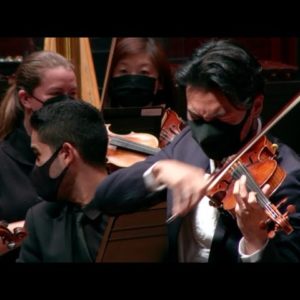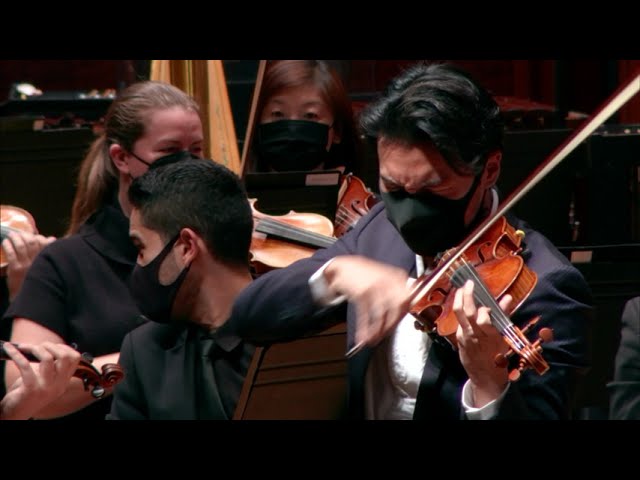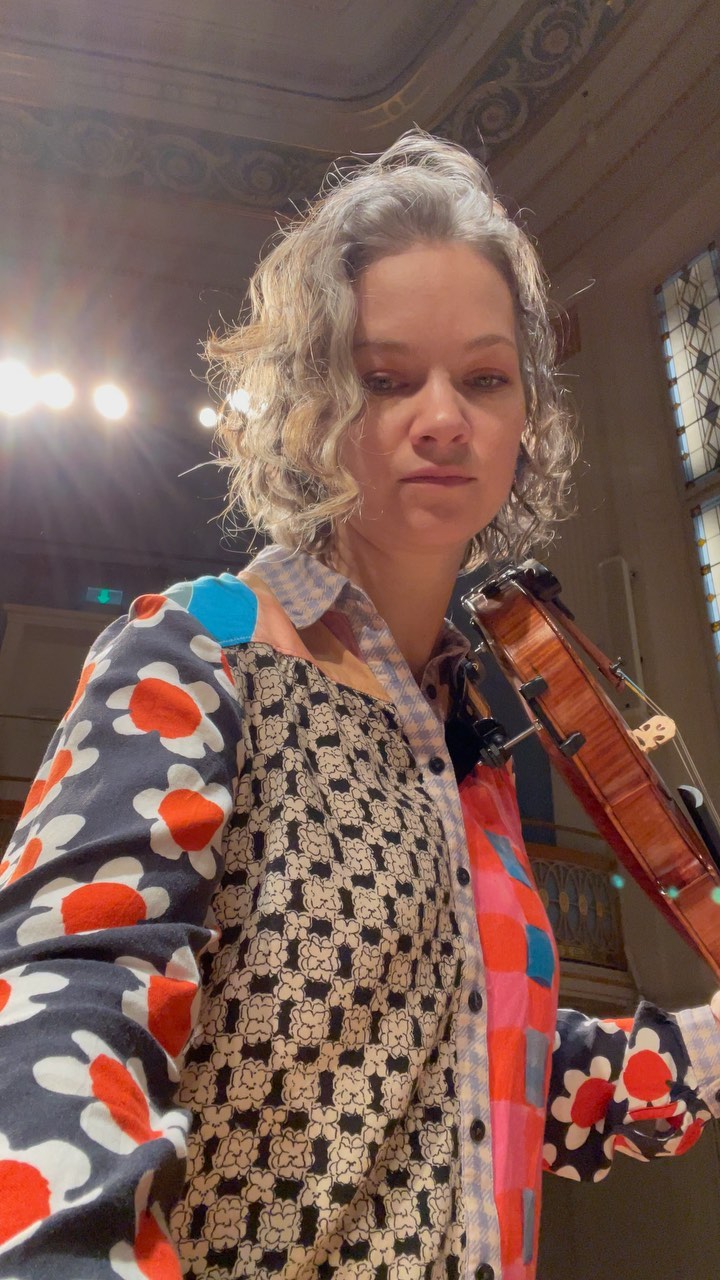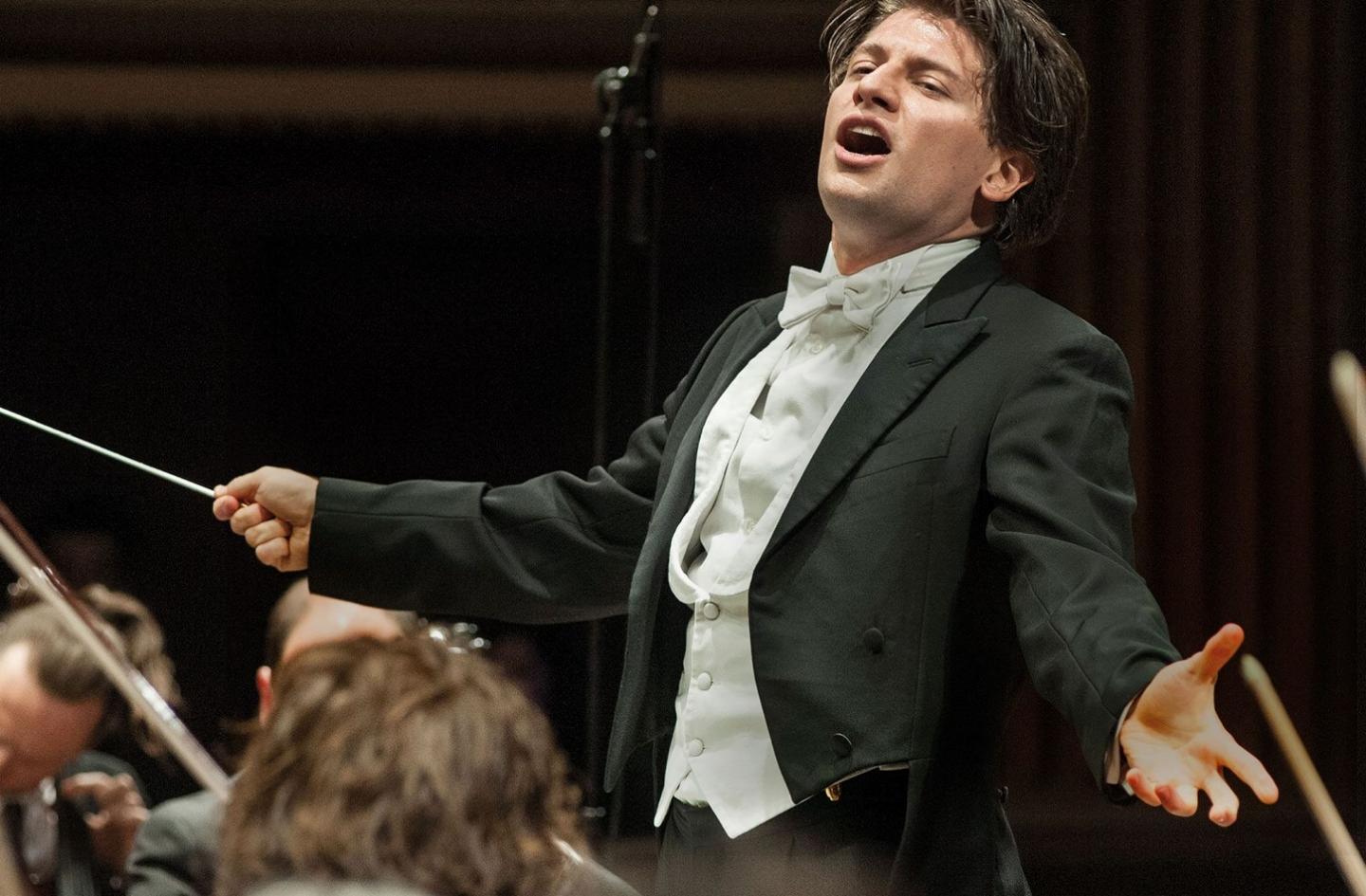When your string breaks in the Tchaikovsky concerto
NewsIn Thursday’s concert with the Seattle Symphony Ray Chen is, as ever, Mr Cool, when a string breaks on his instrument.
He even pays a compliment to the concertmaster’ violin that he borrows.
Watch.
Note that both conductor and soloist are wearing masks.







Some years ago during a concert by the Indianapolis Symphony Orchestra a string on the violin of the concert master broke. The concert master and the associate concert master exchanged violins. The associate concert master reached in his pocket and pulled out a string which replaced the one that was broken. He then tuned it and, at a good time, returned it to the concert master.
Pat, that’s normal.
Standard practice, it happens quite often with gut strings!
But the string he broke was E which I am pretty sure was not gut.
I wasn’t refering to his string!
And I never said you did, but I just made it clearer for those who might misunderstand.
He usually plays with the greatest of E’s.
That is of course a terribly exciting and incredibly fascinating story, but you do realize, I hope, that there is absolutely nothing unusual about it, because a similar situation happens occasionally in every single orchestra on the planet and more often than not it gets solved in a very similar way.
Yes, but it’s a rare experience for most people, so it’s kind of cool to see it in action.
That may be true, but I would go on a limb here and dare to suggest that “most people” do not read slippeDisc, let alone comment on it.
Um… OK
Classy.
This is a well-known convention, but is it a common practice for one or more orchestral violinists to be packing extra strings to do this kind of replacement in the unlikely event of a broken string?
Yes.
It is. We had it happen in our orchestra, with Benjamin Bielman. Same piece (different spot), same procedure. I wouldn’t be surprised if it’s an unwritten part of the ACM’s job always to have a spare set of strings handy.
Maxim Vengerov did the same thing. It was very many years ago. I was at the concert, do not remember what piece he played. A string broke, and he borrowed an instrument from a concertmaster without interrupting the music. At the end he publicly thanked concertmaster.
Wonderful stuff. Maybe the guy it was written for was right: it is unplayable. The violinist handled this superbly.
(Lots of people actually do play it, of course; but we had one well-known soloist mention casually that “everybody” plays this piece, but we shouldn’t forget that it’s still really hard! :-P)
To string players: Is it a fairly common occurrence?
Yes.
The help with the second-desk switch was a nice touch but a real pro would not have made the strumming joke in the cadenza, drawing attention away from the music.
He is a real pro, but he is also a showman. Most, if not all, 19th-century violin cadenzas, including this one, are written not in order to make profound musical statements, but mainly to show off violinistic virtuosity, so a little bit of showmanship while playing one of the prime examples of it is perfectly fine.
Looks like a great set of bells for the Shostakovich Symphony No. 11. Chimes really don’t cut it in that one.
A couple of hefty bells tuned to C and G are also very useful in the finale of Berlioz’s Symphonie Fantastique.
His bow grip seems to release the middle fulcrum (often projecting his middle finger to the conductor) and thus placing more downward pressure into is index. Perhaps he can revisit these technique topics to save more phrases and E-strings; or, being experienced in breakage, maybe it will become part of the show, a la Paganini.
Hats off, Sting Ray!
It’s a kind of problem that happens more frequetly than we will thought in a first time as spectator. I have seen that twice this year in concerts with an harp in a chamber concert and with a violonist close to the konzertmeister. It was for a Mozart symphony and the conductor was Barenboim. At the end of the movment, the violonist has to go backstage and everybody has to wait her 5 mn. But the public and Barenboim stayed calm and the violonist was applaused after. But I imagine that it’s a nightmare.
Ray Chen. No thank you.
The more strings he breaks the better he sounds.
Can anyone shed light on this? There is a legend that sometime pre 1980 the Boston Symphony Chamber Players were doing Stravinsky’s Soldiers Tale. The violinist broke a string, froze for a few seconds, and continued impeccably on three strings! More details anyone?
That probably would have been Joe Silverstein and it sounds entirely plausible.
isn’t there a story about milstein breaking a string [which concerto?] and continuing on three?
How silly they all look with their masks. All of them double-vaccinated, I suppose. Oh, how fooled they’ve been.
What’s the end game here? Vax every third month and double masks?
The end game is not killing people unnecessarily. And I would think wearing a mask is a rather small thing to do to ensure that theatres and concert halls don’t have to shut down again.
“Killing people unnecessarily”. As opposed to the necessary killings, I suppose. Can you tell me more about which killings that are necessary?
Well, leading villains of WW2 come to mind. But in this case, words like preventable and non-preventable may indeed be more accurate.
If you weren’t an asshole you could have interpreted “unnecessarily” to mean “unavoidably.”
Oh well.
We are all entitled to out opinions, and should be free to express them. However, in the interest of balance, I just want to point out that this Peter does not agree with the above Peter’s anti-vax opinion.
Well, actually Peters have been known to deny things for millennia.
Well played, sir.
I love this “anti-vax”- rhetoric. Like taken out of a propaganda book from the 30s. It’s a little like: I love all sorts of Asian food: Indian, Nepalese, Thai – but I’m actually not that fond of sushi.
In your book that makes me an anti-Asian with regards to food. Now I’m waiting for you to explain your fantastic lack of congruence, but let me put it this way: I’m not holding my breath.
Asian food preferences seems to be veering off course a bit, so i’ll ignore that.
The aim of the various protective measures is simply, as a society, to try to protect the lives and health of as many people as we can. And it is done with incomplete but improving understanding of how effective they are. But also the knowledge that some people are trying to make things a bit worse by spreading disinformation.
I hope that helps.
What a childish and irresponsible remark!
You would look sillier intubated or dead from Covid because you have not taken the simple and elementary precautions: mask and vaccine.
I guess all the people in the orchestra are vaccinated. So my question again is: What is the end game her? Masks, vaccines and lockdowns until eternity?
No, only until the “game” ends.
Surprise: It’s never going to end. Corona has come to stay. So what’s your answer then?
The answer will be up to science and not to me.
Car crashes are here to stay. So would you also argue that there’s no point in seatbelts ?
We can’t stop.
We only have the hall until 9:30!
I remember a concert a few years back, when a very well known (Russian) violinist broke the E string twice during cadenza of Tchaikovsky concerto
Nothing to get too excited about here – its an occupational hazard. What is impressive is when you have a string break and carry on regardless, without stopping. Only ever seen this happen once in concert: back in the early 1980s Iona Brown had her E string break about 20 bars from the very end of the Beethoven concerto. She was quick witted enough to recompose the final 3 bars for just the D and A strings. Very impressive and not surprisingly earned her a tremendous ovation.
Class act indeed, and an elegant performance of Tchaikovsky in progress!
In 1956 the Juilliard School of Music celebrated its 50th anniversary with a festival of American music. On the final concert Isaac Stern was guest soloist in William Schuman’s
Violin Concerto. In the very first measure one of his strings
broke (I don’t remember which one). Knowing that the student
concertmaster had the loan of a very fine violin, Stern reached
over to him to exchange violins, and the young man wouldn’t
give it to him. Stern had no recourse but to leave the stage
and change the string himself. He returned and played the
difficult concerto without further mishap.
I also wouldn’t want Stern playing on my violin…
In 1956, Isaac Stern could still play very well. But that student was certainly not likely to have a successful solo career after this incident.
When I break and replace a string, it takes many many days of playing on it with constant retuning before that new string holds pitch. My (late) teacher told me that the replacement strings he carried in his orchestral dress suit pocket had been “pre-stretched” by him to avoid this problem. Whether that is common or not I do not know.
Please specify which strings you use so that I will make sure to avoid them if it takes “many many days of playing…with constant retuning before” they hold pitch. None of mine ever took more than three days. Pre-stretching is not very common, but I have known a couple of extremely careful and dedicated violinists who did that.
The old Eudoxas were infamous for long break-in times. I used Dominants in their ‘Stark” incarnation and they would be fine in a couple of days. I’d say most of the new brands are the same: Evah Pirazzi and Vision Solo are both quite good. The newly introduced Dominant Pros are, IMO, excellent and do break-in fast.
To M2N2K: Thomastik dominant. Three days sounds about right. I’d regard that as “many” days to be annoyed at one’s strings. I’ve had a lifetime to be annoyed at my fingers but that’s a different matter ….
Thanks for replying. )ccasionally I do use Dominants myself. However, my previous comment makes it pretty clear that three days has been the maximum amount of time needed in my experience – it is usually less than that – and I must admit that I have never before heard the number three referred to as not just “many” but “many many”: it leaves virtually no room at all for the word “few”.
Sorry for my funny way of writing/reducing the capital O.
I agree that this event was not all that unusual. What would be interesting to know is whether anyone notices a difference in sound after the switch with the concert master. I’m generally sceptical of the mythology surrounding violins made by the great masters, but, when I witnessed the soloist switch with the concert master at the Bozar in Brussels, there was a marked change in the soloist”s sound. It could be that he was uncomfortable playing a different instrument, but the sound was much more feeble.
First, most concertmasters of major orchestras play on good or very good violins. Second, of course soloists could be uncomfortable when suddenly switching to a different instrument in the middle of performance. Third, the difference in violins’ sound is not a “mythology” – it is a fact: different violins sound differently.
I too expected the concert maste’s violing to be of high quality but there was a noticeable difference.
I certainly agree violins sound different. I was referring to the supposed superiority of violins by the old masters, such as Stradivarius, to high quality new instruments. Blind tests have consistently shown that there is no such superiority.
The difference may be noticeable at least partially because of the second reason that I mentioned above. As for the results of all those blind tests, I can only say from my own experience that maybe I was not lucky enough to hold the best modern violins in my hands, but that not a single Strad out of several on which I was fortunate to play ever disappointed me.
This guy breaks a lot of strings, weird.
Paganini was famous for breaking his strings and playing his work on three strings rather than four to impress the audience.
This is a pretty common occurrence but seems to have captured the media’s attention since it was captured on video.
Great press for classical music all around.
John Philip Sousa told a story from his career as a theater orchestra player where he broke his E string, then his A, then his D, and had to finish the performance on just the G !
Totally true! Would John Philip Sousa lie?
It is undeniably great theatre watching the players switch instruments and continue playing with little interruption to the music’s flow. However, that is not always the best course of action. Much depends on the situation and repertoire. It happened to me when I popped an E string while performing Korngold’s Violin Concerto. The 3rd movement is particularly tricky with its many instances of awkward passagework and unusual configurations. It’s a calculated risk to continue on an unfamiliar violin in the best of cases. Although the concertmaster had a fine violin, knowing the landmines Korngold left for his soloist and the individual vagaries of violins, I decided to stop the performance, go backstage and change the string. While strings routinely take a few days to break in, E strings come along faster, so I was reasonably confident that all would be well with a brand new string. And it was.
Pro tip: before you return to the stage, make sure you play a little bit on it to ensure the new string has a sufficient rosin coating, otherwise, your initial notes could be virtually inaudible.